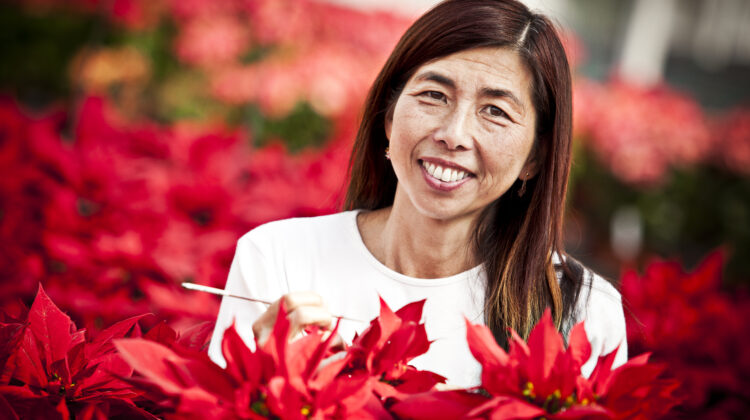
Nurturing Horticultural Excellence and Blooming Achievements
The celebration of exceptional accomplishments within the realm of horticulture goes to Dr. Ruth Kobayashi, who is the distinguished recipient of the esteemed Paul Ecke Jr. Award of Excellence. This prestigious accolade, established through collaboration between the San Diego Botanic Garden and the esteemed Ecke family, pays tribute to individuals who have demonstrated unparalleled contributions to the field of plant cultivation. Join us as we embark on a journey through Dr. Kobayashi’s remarkable endeavors, delving into her profound impact on the world of botanical wonders.
Emerald Magazine: Congratulations to Ruth Kobayashi on receiving the prestigious Paul Ecke Jr. Award of Excellence. Can you tell us more about the significance of this award in the field of horticulture?
Ruth Kobayashi: The Paul Ecke Jr. Award of Excellence was established by the San Diego Botanic Garden and the Ecke family in 2000 to recognize individuals in the San Diego region who have made an outstanding contribution to the field of horticulture. Since 2000, San Diego Botanic Garden has presented the award 22 times.
EM: It is mentioned that you joined Paul Ecke Ranch in 1995. How has your work evolved since then, particularly after the acquisition by Dümmen Orange in 2013?
RK: When I joined the Paul Ecke Ranch in 1995, we exclusively used conventional breeding methods of pollination and seedling selection. The acquisition by Dümmen Orange in 2013, has brought a greater global perspective, the transition from conventional to predictive breeding approach, and additional resources such as the Breeding Technology Centre (BTC). The BTC is home to all of Dümmen Orange’s research facilities in the field of breeding technology and traits, joining scientists and breeders to develop next-generation varieties in a smarter way.
EM: Can you provide insights into some of the specific achievements and breakthroughs that you have made during your career in plant breeding?
RK: One breakthrough achievement was the development of the first interspecific hybrid with poinsettia. Utilizing in vitro technique of embryo rescue, we were able to develop a new type of flowering potted plant with vibrant color and unique qualities that we continue to investigate. Another breakthrough was the development of double-flowered New Guinea Impatiens with rippled, twisted incurved petals. These have flowers with a new type of petal presentation for this species.
EM: Your current focus is on the development of New Guinea impatiens and poinsettia cultivars. What makes these plant varieties significant, and how do they contribute to horticulture?
RK: For 28 years, I have led the poinsettia and New Guinea Impatiens breeding program for the world’s leading suppliers of vegetatively propagated varieties. During this time, I have developed new and novel varieties by extending the array of flower colors and petal/bract shapes in these species. With my deep understanding of these crops and commercial production methods, I also develop varieties that are easier to produce.
EM: Developing over 90 poinsettia and 80 impatiens cultivars is a remarkable achievement. Could you highlight some of your most notable creations, and have any received special recognition in the horticultural community?
RK: Poinsettia cultivars ‘Orange Spice’, ‘Autumn Leaves’, and ‘Golden Glo’ introduced new colors for poinsettia into the marketplace. Euphorbia hybrid ‘Luv U Pink’ introduced a vibrant pink color and greater cold tolerance than regular poinsettias. New Guinea Impatiens cultivar ‘Wild Romance Blush Pink’ and others in the series are the first to have a new type of petal presentation.
EM: How has your work influenced the horticulture industry, and what impact has it had on growers, enthusiasts, and consumers of plants and flowers?
RK: Not looking backward or looking at what competitors are doing, but looking forward to what the market needs. In poinsettia, it’s finding solutions for growers with the development of varieties like Prestige, which defined what V-shaped architecture is, solving big problems for growers like stem breakage. It is also creating value with genetics, something special and unique are what customers like and are willing to pay more for it.
EM: The “Autumn Leaves” poinsettia is mentioned as an award-winning variety. Can you share more details about this specific cultivar and the recognition it has received?
RK: In 2015, Japan Flower Selection (JFS) selected ‘Autumn Leaves,’ also known as ‘Poinsettia Gold,’ for the “Best Flower” award for pot plants. The JFS aims to award the world’s best varieties and improve the buying experience for Japanese customers by recommending which products to buy. This is one of the most competitive awards for the Japanese market in the industry and is subsidized by the Japanese Ministry of Agriculture.
EM: Could you provide some information about Dümmen Orange and its mission in the field of floricultural excellence, as well as how your work aligns with the company’s goals and values?
RK: My objective as a flower breeder is to bring joy through beautiful flowers. Dümmen Orange strives for a more beautiful world. It is a company focused on continuous improvement, passionate about unlimited possibilities, committed to the success of its customers and partners, and acts responsibly toward all people and the planet.
Dr. Ruth Kobayashi’s journey in plant breeding is nothing short of extraordinary. We extend our sincere gratitude to her for sharing insights into her groundbreaking work. As we conclude, let’s appreciate the profound influence her innovations have had on growers, enthusiasts, and consumers of plants and flowers.
Dr. Kobayashi’s dedication to bringing joy through beautiful flowers aligns seamlessly with the mission of Dümmen Orange—a company committed to continuous improvement, unlimited possibilities, and responsibility toward people and the planet.
Thank you, Dr. Kobayashi, for inspiring us with your passion and achievements in the world of floricultural excellence.



Leave a Reply